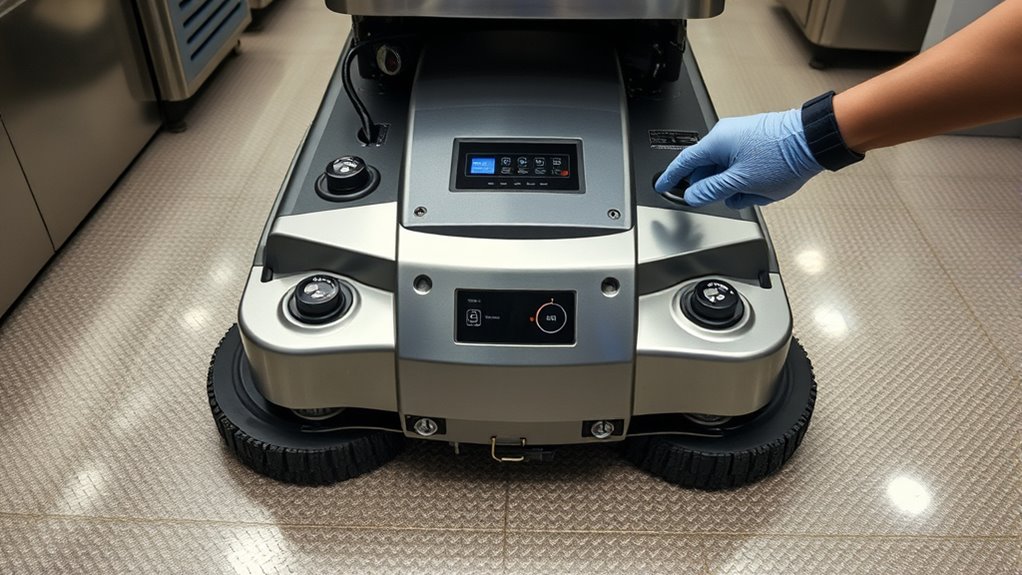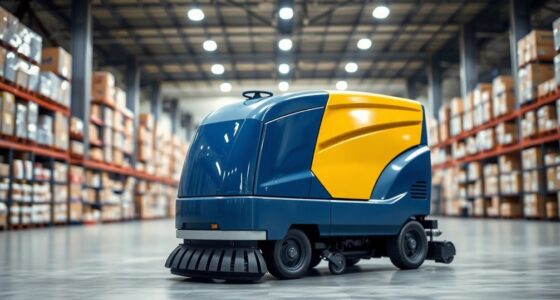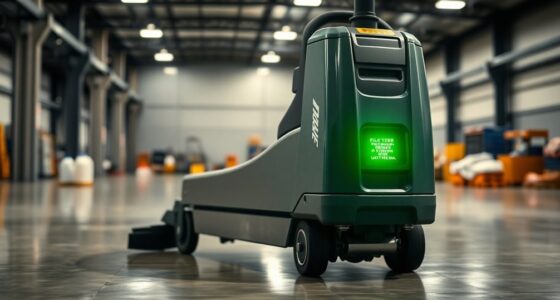When setting up your restaurant kitchen auto-scrubber, choose pads for delicate, smooth floors and brushes for textured, heavily soiled surfaces. Guarantee the attachment is securely installed and spins freely to prevent wobbling. Regularly inspect and replace worn components, and follow safety protocols like wearing gloves and training staff properly. Proper setup and maintenance maximize cleaning efficiency and equipment life. Keep exploring to learn more about optimizing your auto-scrubber’s performance and safety.
Key Takeaways
- Use pads for delicate, smooth flooring; brushes for heavily soiled or textured surfaces.
- Ensure attachment is securely installed and spins freely without wobbling for optimal cleaning.
- Regularly inspect and replace worn pads or brushes to maintain cleaning efficiency.
- Follow safety protocols, including proper handling and equipment setup, to prevent accidents.
- Proper attachment choice and maintenance extend equipment lifespan and improve cleaning performance.

Setting up an auto-scrubber in your restaurant kitchen is a straightforward process that can substantially improve cleaning efficiency. However, to get the most out of your equipment, you need to pay attention to proper setup procedures, including choosing the right scrubbing method—pad versus brush—and adhering to essential maintenance routines and safety protocols. Understanding these elements ensures your auto-scrubber performs efficiently and lasts longer, reducing downtime and repair costs.
First, consider the type of scrubbing surface your kitchen floors require. Pads are typically softer and gentler, making them ideal for delicate flooring or areas that need a thorough, yet gentle clean. Brushes, on the other hand, are more aggressive and better suited for heavily soiled surfaces or textured flooring. When setting up, you’ll need to select the appropriate attachment based on the floor condition and cleaning goals. Proper installation involves securely attaching the pad or brush to the machine, ensuring it spins freely without wobbling. This step is vital to prevent damage to the scrubber and ensure safe operation.
Choose the right attachment—pad for delicate floors, brush for heavy soiling—and ensure it’s securely installed for safe operation.
Once the attachment is correctly installed, you should focus on establishing routine maintenance routines. Regularly inspecting the pad or brush for wear and tear keeps cleaning effective and prevents damage to your floors. Replace worn or damaged pads and brushes promptly—this not only maintains cleaning quality but also extends the lifespan of your equipment. Checking the solution and recovery tanks for clogs or buildup helps maintain consistent water flow and suction power. Keep the filters clean and replace them as recommended by the manufacturer. These simple routines reduce the risk of breakdowns and keep your auto-scrubber running smoothly. Additionally, understanding how Chevrolet Tuning techniques can optimize engine performance highlights the importance of proper maintenance routines for longevity.
Safety protocols are equally essential during setup and operation. Always wear protective gloves and eyewear when handling cleaning attachments or chemicals. Before starting, ensure the area is clear of obstacles and that cords or hoses are positioned to prevent tripping hazards. Training your staff on proper operation minimizes accidents and promotes safe use of the equipment. Additionally, verify that the auto-scrubber’s emergency shut-off features are functional and that the machine is grounded correctly to avoid electrical hazards.
Frequently Asked Questions
How Often Should I Replace the Pads or Brushes?
You should replace your pads or brushes when you notice reduced cleaning performance or visible signs of wear. Typically, pads have a lifespan of about 50-100 hours of use, while brushes are more durable but may need replacing every few months depending on usage. Regularly inspect for fraying, cracks, or wear to guarantee ideal cleaning. Maintaining good pad lifespan and brush durability keeps your auto-scrubber working efficiently and extends its overall lifespan.
Can Auto-Scrubbers Be Used on All Floor Types?
Auto-scrubbers can be used on many floor types, but you need to check floor compatibility first. Not all surfaces handle pads or brushes well, especially delicate materials like hardwood or vinyl. Look for models with pad versatility, which allow you to switch between different attachments for various surfaces. Always test a small area first to make sure the auto-scrubber won’t damage the floor, and adjust settings accordingly for ideal cleaning.
Are There Eco-Friendly Pad or Brush Options Available?
You might worry eco-friendly options aren’t effective, but many are! You can find auto-scrubber pads and brushes made from eco-friendly materials and biodegradable options that clean just as well as traditional ones. These environmentally conscious choices help reduce waste and minimize your carbon footprint without sacrificing cleanliness. Switching to biodegradable options supports sustainability while keeping your restaurant spotless, making it a smart, responsible move for eco-minded operations.
What Maintenance Is Required for Optimal Performance?
To keep your auto-scrubber performing efficiently, regularly inspect and replace worn pads or brushes to maintain effective cleaning. Prioritize floor safety by ensuring the equipment is clean and in good condition to prevent slips. Proper operator training is essential, teaching users how to operate and maintain the machine correctly. Routine maintenance, including checking for debris and proper fluid levels, ensures longevity and ideal cleaning results.
How Do I Troubleshoot Common Auto-Scrubber Issues?
If your auto-scrubber isn’t working properly, start troubleshooting power issues by checking the power cord and outlet. For battery problems, verify the battery is fully charged and connections are secure. If the machine still won’t operate, inspect the fuse or circuit breaker. Regularly clean the battery terminals and check for any corrosion. These simple steps can help you quickly identify and resolve common auto-scrubber issues.
Conclusion
Now that you’ve unraveled the mystery between pads and brushes, you’re ready to orchestrate a spotless symphony in your kitchen. Think of your auto-scrubber as a trusty sidekick, wielding its tools like a painter’s brushstrokes or a dancer’s graceful pad movements. With the right setup, your floors will shine brighter than a star, turning your restaurant into a sparkling haven. Embrace the choice, and watch your cleaning routine become a smooth, unstoppable rhythm.









